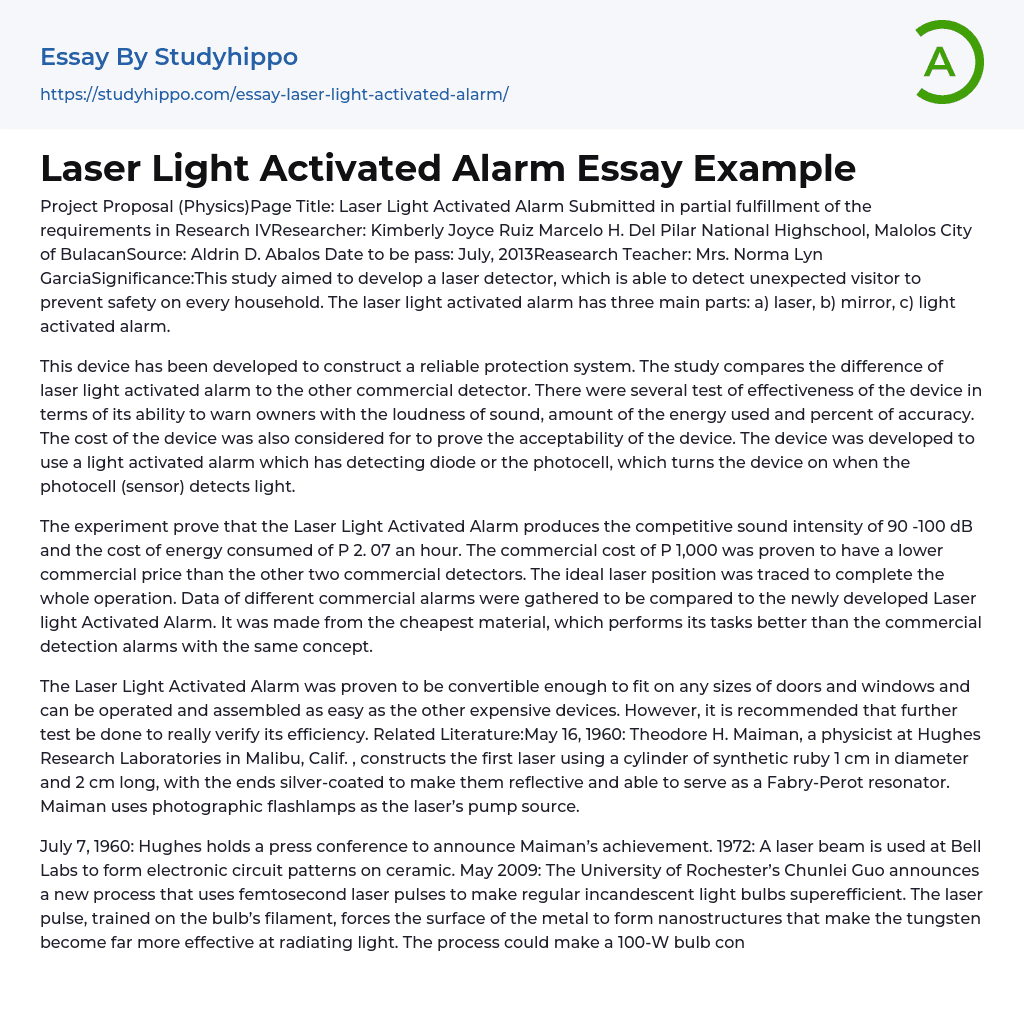Project Proposal (Physics)
Page Title: Laser Light Activated Alarm
Submitted in partial fulfillment of the requirements in Research IV
Researcher: Kimberly Joyce Ruiz
Marcelo H. Del Pilar National Highschool, Malolos City of Bulacan
Source: Aldrin D. Abalos
Date to be pass: July, 2013
Reasearch Teacher: Mrs. Norma Lyn Garcia
Significance:
The objective of this study is to develop a laser detector capable of identifying unexpected visitors and preventing safety hazards in households. The laser light activated alarm comprises three main components - a) laser, b) mirror, c) light activated alarm.
This device was created to develop a trustworthy security system. The research compares the discrepancy between a laser light activated alarm and other detectors available on the market. Several tests were conducted to evaluate the device's effectiveness in terms of sound intensity,
...energy consumption, and accuracy percentage. Additionally, the cost of the device was taken into account to demonstrate its acceptability. The device utilizes a light activated alarm that includes a detecting diode or photocell. This allows the device to activate when the photocell (sensor) detects light.
The experiment demonstrated that the Laser Light Activated Alarm produces a competitive sound intensity of 90-100 dB and consumes energy at a cost of P 2.07 per hour. It was proven that the commercial cost of P 1,000 was lower than the price of the other two commercial detectors. The ideal laser position was identified in order to achieve optimal performance. Data from different commercial alarms were gathered and compared to the newly developed Laser Light Activated Alarm. This alarm, made from inexpensive materials, outperforms other commercial detection alarms with the same concept.
The Laser Light Activated Alar
has been proven to be adaptable to fit any size of doors and windows, and it can be easily operated and assembled similar to more expensive devices. However, it is recommended to conduct further tests in order to confirm its efficiency.
Related Literature:
On May 16, 1960, Theodore H. Maiman, a physicist at Hughes Research Laboratories in Malibu, Calif., constructs the first laser by using a 1 cm diameter and 2 cm long cylinder made of synthetic ruby. The ends of the cylinder are silver-coated to allow them to reflect and function as a Fabry-Perot resonator. Maiman utilizes photographic flashlamps as the laser's pump source.
Howard Hughes announced Maiman's achievement during a press conference held on July 7, 1960. In 1972, Bell Labs utilized laser beams to create electronic circuit patterns on ceramic materials. Then in May 2009, Chunlei Guo from the University of Rochester introduced a new technique that uses femtosecond laser pulses to enhance the efficiency of regular incandescent light bulbs. By directing the laser pulse onto the bulb's filament, nanostructures form on the metal surface and significantly improve tungsten's light emitting capability. Guo suggests that this process has the potential to reduce electricity consumption of a 100-Watt bulb to that of a 60-Watt bulb.
This is a laser alarm system resembling those seen in movies. It utilizes a laser pointer beam to safeguard your belongings and property. When the beam is interrupted by a person, animal, or object, the resistance of a photodiode increases and triggers an alarm. The laser and receiver can be placed together in a single box, sharing a power supply. The receiver's average current consumption is under
10 mA, making the laser the device that requires the most current. The diagram provides examples of a passage and an area that are protected by the alarm, with mirrors used to direct the beam as needed.
The circuit diagram contains a TL072 op-amp (IC1. A) that acts as a voltage comparator. It compares the voltage reference from the adjustable voltage divider P1/R4 with the light-dependent voltage from the voltage divider made up of photodiode D1 and fixed resistor R3. When the laser beam is interrupted, the voltage at comparator pin 2 becomes lower than that at pin 3. As a result, the output swings towards the positive supply voltage, indicating an alarm condition. This signal can be used to activate a siren, a computer, or a light in order to deter the intruder.
- Incandescent Light Bulb essays
- Atom essays
- Big Bang Theory essays
- Density essays
- Electricity essays
- Energy essays
- Force essays
- Heat essays
- Light essays
- Motion essays
- Nuclear Power essays
- Physiology essays
- Sound essays
- Speed essays
- Temperature essays
- Thermodynamics essays
- Alternative Energy essays
- Energy Development essays
- Nuclear Energy essays
- Solar Energy essays
- The elements essays
- Voltage essays




